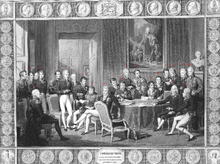Karl Robert von Nesselrode

Karl Robert Reichsgraf von Nesselrode-Ehreshoven ( Russian Карл Васильевич Нессельроде / Karl Wassiljewitsch Nesselrode ; * December 14, 1780 in Lisbon ; † March 11, July / 23 March 1862 greg. In Saint Petersburg ) was a Russian diplomat , foreign minister and chancellor .
Life
Family and youth
The Nesselrode family was an old Bergisch noble family , but had been living in Livonia for a long time . With his baptism in the chapel of the British Embassy, he was born out of consideration for his Protestant mother Luise. Gontard (1746–1785) Member of the Church of England . His father Wilhelm von Nesselrode (1728–1810) was the Russian envoy in Lisbon, Portugal . Canon Johann Franz von Nesselrode-Ehreshoven (1754–1816) was his uncle.
In 1787 his father became the Russian ambassador to Prussia , and Karl Robert received his school education in Berlin . At the age of 16, he entered the Russian Navy, and through the influence of his father, he received the position of orderly with Tsar Paul . He switched to the army (under Tsar Alexander I ) and finally to the diplomatic service.
Although he represented the political and diplomatic interests of the Russian Empire for decades, Nesselrode could neither read nor write the Russian language and could only speak brokenly.
diplomat
In 1802 he worked for the Russian legation in Berlin, then for the one in Stuttgart . From 1805 to 1806 he worked as a legation secretary and chargé d'affaires in The Hague . In 1806 he traveled to southern Germany to report on the French troops operating there. He then became the diplomatic secretary of Generals Michail Kamenski , Buxhoeveden and Levin August von Bennigsen . In February 1807 he took part in the Battle of Preussisch Eylau and the subsequent negotiations for the Peace of Tilsit . In 1807 he was appointed counselor in Paris .
Statesman
In the war between Russia and France from 1812-1814, Nesselrode drafted many notes, declarations and treaties issued by the allied powers, including the Peace of Paris of May 30, 1814.
In 1814 Nesselrode became State Secretary. During the Congress of Vienna he was head of the Russian delegation, with Tsar Alexander I often acting as his own foreign minister through his personal participation. On August 9, 1816, Nesselrode became Foreign Minister. On January 7, 1819, King Friedrich Wilhelm III awarded him . of Prussia the Order of the Black Eagle for his services (source: Louis Schneider: Das Buch vom Schwarzen Adler, page 207 (31), Duncker, Berlin, 1870). Until his resignation in 1821, he worked with the State Secretary Count Ioannis Kapodistrias .
For a period of almost forty years Nesselrode was considered one of the leading conservative politicians of the Holy Alliance . He accompanied Alexander I to the congresses in Aachen , Troppau , Laibach and Verona . Under Emperor Nikolaus , who in 1826 granted him important possessions in southern and western Russia, he became Vice Chancellor in 1829 and Chancellor of the Russian Empire in 1845 .
Important events of his tenure were the intervention of Russian troops in Hungary in 1849 to suppress the uprising led by Lajos Kossuth against the Habsburgs , as well as the Crimean War , which ended with a defeat for Russia. Nesselrode took part in the negotiations for the Paris Peace of March 30, 1856 to end the Crimean War.
On April 15, 1856 he took his leave. Already before, on June 16, 1851, King Friedrich Wilhelm IV of Prussia had awarded him the higher level of diamonds in addition to the Order of the Black Eagle (Source: List of Knights of the Royal Prussian High Order of the Black Eagle, page 18, Decker, 1851) . His autobiography was published posthumously in 1866. His successor as Foreign Minister was Prince Alexander Mikhailovich Gorchakov . Nesselrode had two daughters, Elena Karlovna (1815–1875) and Marija Karlovna (1820–1888). His only son, Count Dimitri von Nesselrode (1816-1891), was also in the Russian service Council of State and Imperial Court Master.
memory
The names of various dessert dishes with pureed chestnuts are reminiscent of Nesselrode , such as creme a la Nesselrode , ice cream after Nesselrode , an ice cream bomb with chestnuts and maraschino , and Nesselrode pie . The original recipe is said to come from Nesselrode's cook in Paris.
literature
- Clemens Graf von Looz-Corswarem : Nesselrode, von. In: New German Biography (NDB). Volume 19, Duncker & Humblot, Berlin 1999, ISBN 3-428-00200-8 , pp. 73 f. ( Digitized version ). (Family item)
- Ulrike Eich: Nesselrode, Robert Graf von. In: New German Biography (NDB). Volume 19, Duncker & Humblot, Berlin 1999, ISBN 3-428-00200-8 , pp. 74 f. ( Digitized version ).
- Hennig Gritzbach: The Russian Chancellor Count Nesselrode (1780–1862). Dissertation Erlangen / Nuremberg 1974.
Web links
- Works by and about Karl Robert von Nesselrode in the German Digital Library
- Entry on Karl Robert von Nesselrode in Kalliope
- Article by Karl Robert von Nesselrode in the Great Soviet Encyclopedia (BSE) , 3rd edition 1969–1978 (Russian)
Individual evidence
- ^ Encyclopædia Britannica
- ↑ Orlando Figes : Natasha's Dance. A cultural history of Russia . Henry Holt, New York 2002, ISBN 0-312-42195-8 , pp. 55 (English).
- ↑ recipe
- ^ The Culinary Mystery of Nesselrode Pie , New York Times, December 7, 1988, accessed June 15, 2017
| personal data | |
|---|---|
| SURNAME | Nesselrode, Karl Robert von |
| ALTERNATIVE NAMES | Карл Роберт Васильевич Нессельроде |
| BRIEF DESCRIPTION | Russian diplomat and statesman |
| DATE OF BIRTH | December 14, 1780 |
| PLACE OF BIRTH | Lisbon |
| DATE OF DEATH | March 23, 1862 |
| Place of death | St. Petersburg |

